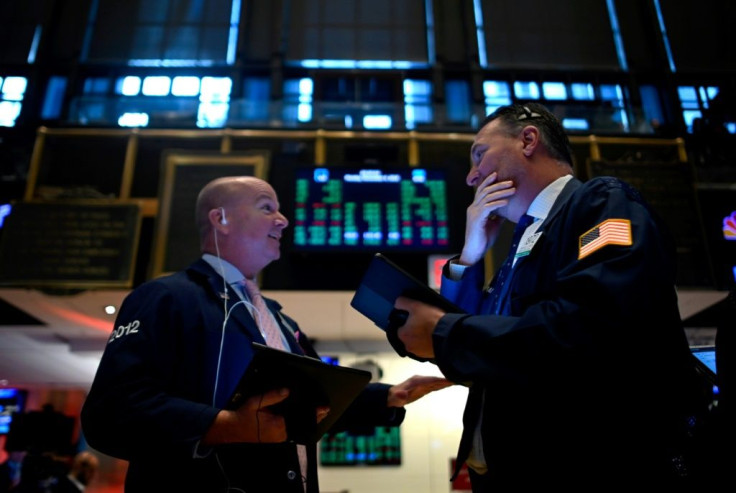Tuesday's Stock Market Close: US Equities Suffer Steep Losses For Second Straight Day, Bond Yields Sink

KEY POINTS
- CDC warned of possibility of virus outbreak in US
- U.S. stock indexes have posted huge daily losses in same month they set record highs
- Treasury yields have plunged
U.S. stocks plunged for a second straight day on Tuesday over deepening worries about the magnitude of the coronavirus outbreak and its impact on the global economy. The Centers for Disease Control and Prevention warned that a coronavirus outbreak could occur in the U.S.
The Dow Jones Industrial Average plunged 880.79 points to 27,080.01 while the S&P 500 dropped 97.59 points to 3,128.30 and the Nasdaq Composite Index fell 255.67 points to 8,965.61.
The S&P 500 hasn’t logged back-to-back declines of more than 3% since November 2008 during the depths of the global financial crisis. In February 2018 the Dow Jones suffered two daily declines of more than 1,000 points each.
Volume on the New York Stock Exchange totaled 4.6 billion shares with 279 issues advancing, 51 setting new highs, and 2,716 declining, with 363 setting new lows.
Active movers were led by NIO Inc. (NIO), Ford Motor Co. (F) and Advanced Micro Devices Inc. (AMD).
“Current global circumstances suggest it’s likely this virus will cause a pandemic,” said Anne Schuchat, principal deputy director of the Centers for Disease Control and Prevention. “It’s not so much a question of if this will happen any more, but rather more a question of when this will happen and how many people in this country will become infected and how many of those will develop severe or more complicated disease."
Dr. Nancy Messonnier of the CDC, said: “We are asking the American public to work with us to prepare in the expectation that this [virus] could be bad.”
Virus infections have now spiked in South Korea, Italy and Iran. Cases have also been confirmed in Spain and elsewhere. In China, the number of infections approached 80,000.
“We increasingly find it hard to believe that [U.S.] cases are as low as reported, and believe that given the flow of Chinese, Korean and Iranian nationals into North America, a large [U.S.] community-based outbreak is increasingly likely,” wrote Simon Powell, equity strategist with Jefferies. “If not managed correctly, this could significantly rattle markets.”
Art Hogan, chief market strategist at National Securities, said: “What’s scary about this particular drop from the all-time high is it has snuck up on us so quickly in a short period of time. When you juxtapose that against a mentality of ‘We don’t know how big this thing can get,’ that makes it feel like it’s a bottomless reaction in the market.”
Usually, stocks rebound after a day of heavy losses. But not this time.
Matt Maley, an equity strategist at Miller Tabak & Co. commented that: “It’s the realization that the market was not going to bounce like it usually does after a severe one-day decline. Once that became obvious, the short-term traders started selling and the long-term investors pulled in their horns.”
Federal Reserve Vice Chairman Richard Clarida said the central bank is closely monitoring coronavirus, but added it is “still too soon” to determine if the spread will result a material change to the economic outlook.
Oxford Economics estimated the virus epidemic may wipe out more than $1 trillion from the global domestic product.
Fears over the virus overshadowed some economic news.
In December, home prices climbed by 3.8% on the S&P CoreLogic Case-Shiller National Home Price Index, versus a 3.5% gain in November.
“The U.S. housing market continued its trend of stable growth in December,” said Craig J. Lazzara, managing director and Global Head of Index Investment Strategy at S&P Dow Jones Indices.
The Conference Board’s consumer confidence index came in at 130.7 for February, up from 130.4 in January, but below economists’ expectations of a 132.6 reading.
U.S. house prices rose 5.1% in the fourth quarter of 2019 on a year-over-year basis, reported the Federal Housing Finance Agency.
Overnight in Asia, markets finished mixed. China’s Shanghai Composite slipped 0.6%, while Hong Kong’s Hang Seng edged up 0.27%, and Japan’s Nikkei-225 fell 3.34%.
In Europe markets finished broadly lower, as Britain’s FTSE-100 fell 1.94%, France’s CAC-40 tumbled 1.94% and Germany’s DAX dropped 1.88%.
Crude oil futures plunged 3.13% at $49.82 per barrel and Brent crude slipped 0.39% at $54.05. Gold futures dropped 2.15%.
The euro gained 0.26% at $1.0883 while the pound sterling gained 0.56% at $1.3003.
The yield on the 10-year Treasury plunged 3.41% to 1.33% while yield on the 30-year Treasury dropped 1.8% to 1.804%.
© Copyright IBTimes 2025. All rights reserved.




















